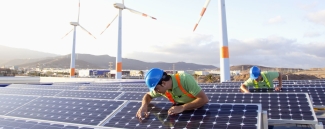Seemingly every day, new cities, organizations, schools and transportation systems declare their intent to decarbonize. Decarbonization refers to the goal of ending our dependence on oil and gas as power sources to reduce the carbon dioxide (or CO2) emissions that raise global temperatures. While this commitment is commendable, nearly all global power systems rely on fossil fuels. One of the most important steps to decarbonize is to reduce our reliance on and use of fossil fuel–generated power.
PEER certification can be useful in a power system’s journey toward decarbonization. PEER offers a measurable pathway to increase use of on-site renewables, improve efficiency, and lessen reliance on fossil fuels for transportation systems, campuses, microgrids, cities and utilities.
Through certification, PEER recognizes and celebrates industry leaders improving their efficiency, day-to-day reliability and overall resilience. PEER certification signifies that a system is resilient in the face of disasters, reliable in its ability to meet everyday needs and sustainable in a way that prioritizes efficiency, reducing carbon emissions.
Check out some of the ways PEER helps power systems decarbonize:
1. PEER encourages on-site clean energy sources and storage options to reduce reliance on fossil fuels.
As microgrids, utilities and transit systems come to rely less and less on fossil fuels, their carbon emissions reduce accordingly. The PEER rating system offers incentives for power systems to bolster their independence through the addition of on-site renewables.
Key PEER credit: Energy Efficiency (EE) credit: Distributed Energy Resources—Options 1, 2 and 4.
2. PEER helps projects identify, measure and benchmark their emissions to learn where they can improve.
Through Environmental Performance Disclosures, PEER ensures that projects measure the decarbonization impact and environmental consequences of power generation, transmission and distribution to better understand their impact.
Key PEER credit: EE Prerequisite: Environmental Performance Disclosure.
3. PEER strategies minimize power transmission and distribution loss to increase effectiveness.
By identifying existing inefficiencies, PEER-certified projects adopt new strategies—such as local renewable generation, distributed generation, energy storage and district energy systems—to reduce emissions within their system.
Key PEER credit: EE Prerequisite: System Energy Efficiency Coefficient Disclosure; EE Credit: Distributed Energy Resources.
4. PEER encourages the adoption of off-site renewable energy sources, RECs and carbon offsets to mitigate the effects of existing power distribution.
Where on-site renewables aren’t possible, PEER-certified projects find additional pathways to mitigate their carbon impact.
Key PEER credit: EE Credit: Renewable Energy and Carbon Offsets.
5. PEER spurs energy conservation programs to reduce demand.
Energy conservation leads to emission conservation. Load conservation and management efforts reduce demand on the power system, making it more resilient to unexpected events.
Key PEER credit: Grid Services (GS) credit: Demand-Side Management.
PEER is here to help power systems prepare for the challenges and opportunities of the 21st century. See if your project could be a good fit.
